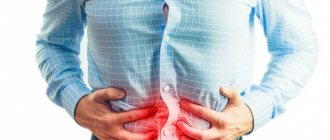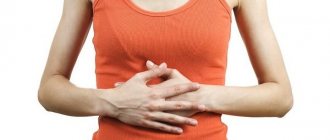Causes of colic in the stomach
Cramping pain can appear due to diseases of the gastrointestinal tract: gastritis, ulcers or erosion of the stomach, inflammation of the mucous membrane of the organ, inflammatory processes in the duodenum.
When these diseases worsen, the following factors can provoke pain:
- Failure in the diet, when the time of eating has changed sharply, a person overeats or goes hungry for a long time. If the patient does not eat three times, as expected, but once or twice. Colic appears in the stomach if fatty, fried, spicy dishes, with a lot of salt appear on the menu;
- Poisoning with stale food or surrogate alcohol can cause stomach spasms, so a person will begin to experience pain in the abdominal area;
- Pain and colic occur due to allergic reactions and uncontrolled use of medications. Also, the appearance of these symptoms in adults is caused by a large amount of strong tea or coffee drunk during the day, tobacco smoke;
- Cramping pain appears if a person is overweight, in a state of neurosis or prolonged depression;
- In older people, pain appears for organic reasons, this is due to the fact that colic is a consequence of some disease of the digestive tract;
- Functional disorders occur not only in adults, but also in young patients, because they eat mostly snacks and dry foods.
In order to get rid of cramping abdominal pain, you need to identify the main reasons that cause them. After this, begin direct treatment of the disease, rather than eliminating its symptoms.
In what cases should you call an ambulance?
If you experience cramping abdominal pain, which is accompanied by a number of dangerous symptoms, you should immediately call a doctor. These symptoms include:
- an increase in temperature to 39°C or higher with diarrhea (especially with bloody discharge in the stool) - this may be dysentery;
- “acute abdomen”, in which the abdominal muscles are painfully tense and hard to the touch - this may be a sign of intestinal rupture or perforation of the stomach wall as a result of injury, internal bleeding and other dangerous phenomena;
- severe bloating accompanied by constipation and vomiting is a sign of intestinal obstruction;
- unbearable “dagger” pain in the abdomen and loss of consciousness are a sign of perforation of the stomach wall.
Any pain in the abdominal area should not be ignored. Both men and women should monitor the functioning of the gastrointestinal tract in order to detect in time the onset of the development of various diseases and disorders.
Treatment of cramping pain in the stomach
- To get rid of colic in the case of gastritis, secretocorrective procedures will help. The stomach is affected with the help of hydrocarbonate-chloride mineral waters, such as “Narzan”, “Karachinskaya”, “Zheleznovodskaya”, “Izhevskaya”, “Essentuki No. 4”, which contain sodium and potassium ions. Thanks to this treatment, the production of acid in the gastric juice is reduced, and a protective effect is exerted on the gastric mucosa;
- The vegetative-corrective method involves influencing the patient’s body with natural factors. For gastritis, aerotherapy is performed - this is a method of treatment using air. This therapy regulates various processes occurring in the stomach, stimulates the synthesis and breakdown of substances in the gastrointestinal tract, increases the activity of blood supply and microcirculation in the diseased organ;
- To get rid of colic caused by gastric or duodenal ulcers, you can use electrosonotherapy, during which a low-frequency current is applied to the patient's brain. Carrying out treatment in this way, the metabolic processes taking place in the body are normalized, emotional stress is reduced, diseased organs are saturated with oxygen, and their blood supply improves;
- Electrical stimulation with low-frequency currents helps reduce pain by affecting areas of the cerebral cortex;
- UHF helps with the acute form. Just 3-5 sessions can relieve the exacerbation.
Quick and easy help
Don't know what to do if you have a stomach ache? If you know how and where your stomach hurts and are sure that the problem is with this organ, before consulting a doctor, you can try simple but effective techniques:
- Apply cold (not ice!) to the area of pain for a short time;
- Ensure peace - lie down or recline;
- If you have hunger pains, a small portion of warm soup, preferably pureed, will help;
- You can only drink non-carbonated water at room temperature;
- If the cause is poisoning, you need to take activated carbon.
These steps should help, but if you experience a repeat episode of stomach pain, you should definitely see a doctor.
How to relieve colic with medications
- To eliminate pain, antispasmodics are prescribed - Drotaverine, Akabel, Baralgin, Papaverine;
- If the disease is caused by bacteria, antibacterial therapy is carried out using drugs such as Erythromycin, Amoxicillin, Levofloxacin, Clarithromycin;
- To normalize microflora, probiotics are used - Bifidumbacterin, Baktisubtil, Linex, Florin.
If the disease has taken an advanced form and drug therapy does not have an effect, surgery is resorted to.
Stomach ulcer
Peptic ulcer of the stomach is a chronic, protracted disease characterized by local damage to the lining of the stomach and the appearance of ulcerated areas. Stomach ulcers are caused by the bacterium Helicobacter pylori.
The mechanism for the development of ulcers is very simple: the bacteria enters the body, the immune system is not able to overcome it. The first thing that develops is gastritis (with gastritis the stomach hurts very much), which leads to increased production of the hormone gastrin
. Gastrin, in turn, provokes an increase in the production of gastric juice, which destroys the structure of the mucous membrane, and ulcers form on it.
If you have frequent pain in the upper abdomen during or after meals, you feel weak and suffer from heartburn, you often feel nauseous and you don’t know what to do about this condition, then you should go to the hospital. Pain and heartburn may be symptoms of chronic stomach ulcers
.
You need to undergo a gastrointestinal examination if your body temperature is around 37-38°C. Often this disease may not bother the patient with symptoms for more than several years
. The exacerbation is seasonal. The worst period for ulcer sufferers is spring and autumn, when the stomach area is very painful.
The first thing you should do if you suspect you have a stomach ulcer is not to put off visiting a gastroenterologist. It is necessary to pass all tests and complete a full course of examinations.
Folk remedies
- For gastritis, you can drink an infusion of peppermint leaves. The essential oil contained in the plant helps expand the capillaries of the stomach and relieves pain. The drug is prepared as follows: four hundred twenty-five grams of the plant are poured with three glasses of olive oil and kept in a water bath for two hours, then filtered. Sixty minutes after eating, drink one tablespoon. Therapy is carried out three times a day, the course continues until a positive effect appears;
- Wormwood tincture will help get rid of gastritis. The bitterness contained in the plant increases the activity of the digestive tract. The medicine is prepared from one part herb and five parts alcohol. Take the drug twenty minutes before meals three times a day, fifteen to twenty drops. Treatment continues until the symptoms of the disease are completely eliminated;
- Take 2 tbsp. l. St. John's wort, nettle and chamomile. Steam the raw material with 500 ml of boiling water and leave for an hour. Filter the infusion and take a glass of the product. The remaining infusion is drunk during the day in 3-4 doses;
- Chamomile and immortelle are taken in equal proportions. Brew 2 tbsp in a glass of boiling water. l. raw materials. After 30 minutes, filter. Drink 100 ml 3 times daily for 2-3 weeks half an hour before meals;
- You can relieve the spasm by taking a teaspoon of freshly squeezed motherwort juice, after dissolving it in a glass of water.
All methods of therapy are carried out only after consulting the attending physician, identifying the cause why the epigastric area suffers.
Correct actions for stomach pain
Characteristic symptoms of diseases of the digestive tract are nausea, diarrhea, vomiting and sharp girdle pain radiating to different parts of the stomach. Sometimes all this occurs regardless of food intake
. Almost every person has experienced this condition, so you should know the rules and sequence of actions to make you feel better.
If malaise occurs frequently and you already have experience with drug treatment, then you can first take a painkiller or antispasmodic drug, after washing your stomach from food - this will relieve tension and pain. As soon as the desired relief occurs, you can analyze the situation in detail and, if necessary, immediately consult a doctor.
Pain in one area can be the cause of several diseases. Spasms can radiate to the back during ovarian spasms, as well as with renal colic, pancreatitis
.
If this situation has arisen for the first time, doing something on your own or taking painkillers is prohibited, as this will prevent the doctor from making a correct diagnosis
. Nausea, diarrhea, vomiting, which indicate banal poisoning, can actually be an infectious disease, and if you take one antibiotic tablet, the cause of the illness will not go away, and the condition will only improve for a short time.
Causes of pathology
Cramping pain in the stomach area can either be a consequence of an existing pathology or indicate a new disease. Do not forget that pregnancy can also cause such sensations. Gastrointestinal diseases that cause pain:
Very important! Savina G.: “I can recommend only one remedy for the quick treatment of ulcers and gastritis” read more.
- intestinal obstruction;
- gastritis;
- colitis;
- ulcer of the gastric mucosa.
Other diseases that cause pain in the abdominal cavity:
- improper diet;
- intoxication with exotoxins from poor-quality food or large amounts of alcoholic beverages consumed;
- a consequence of taking medications;
- exposure to food allergens;
- disorders of the central nervous system due to a stressful environment;
- addiction to tobacco, caffeine;
- physical damage to the stomach and peritoneum.
Return to contents
Peptic ulcer
Ulcerative damage to the mucous membrane causes a different type of pain - from a nagging discomfort to a sharp, acute, cramping and painful pain syndrome with a burning sensation, which is difficult to extinguish by taking analgesics. Stomach pain occurs due to the formation of bacteria of the genus Helicobacter pilori, so therapy is carried out with the mandatory intake of antibiotic substances. The disease also manifests itself due to the use of medications - Diclofenac, Aspirin, drugs to support heart rhythm. An improper diet also causes ulcers.
THIS IS REALLY IMPORTANT! Right now you can find out a cheap way to get rid of stomach pain. FIND OUT >>
Inflammation of the mucous membrane
Serious illness with cramping pain. The cause of the disease can be taking medications, poor diet, stress, high concentrations of Helicobacter pilori bacteria, poisoning with chemicals (alkali, acids). Sharp, piercing pain in pathology does not go away for a long time. With such pain, the patient experiences the following symptoms:
- flatulence, diarrhea;
- weight loss;
- belching;
- lack of desire to eat.
If you start the process of timely treatment of gastritis, ulcerations appear on the gastric mucosa.
Other diseases
It is worth remembering that cramping pain in the peritoneum can also be caused by other gastrointestinal pathologies. The main additional causes of pain may be the following diseases or circumstances:
PAY ATTENTION! Do not prolong gastritis or an ulcer until stomach cancer, it is better to be on the safe side, but this will be necessary. read the story of Galina Savina >>
- intestinal obstruction or appendicitis;
- cholecystitis - inflammation of the gallbladder;
- pregnancy;
- pancreatitis is an inflammatory process of the pancreas.
Return to contents
Appendicitis
The etiology of this disease is uncertain. The disease manifests itself due to the inflammatory process in the appendix. The primary signs will be cramping, grasping pain in the epigastric zone the day before the onset of other symptoms, located slightly lower relative to the peritoneal region. The pain is accompanied by retching, vomiting, and an increase in temperature to 38.5-39 degrees.
Pancreatitis
Gripping pain is characteristic of inflammation of the pancreas. The pain syndrome associated with the disease has varying degrees of intensity, but mainly in the epigastric region the pain is severe and sometimes this discomfort leads to mental disorders. Sometimes the pain shifts to the area of the left rib. Thus, the symptoms can be confused with angina.
Cholecystitis
Inflammation of the gallbladder responds to cramping spasms. The localization of signs of the disease is under the right rib. Sometimes the pain moves to the upper part of the peritoneum. The non-calculous form is accompanied by secondary dyskinesias, which determines the nature of the pain syndrome. The pain is constant, aching and mildly expressed with a burning sensation. If the spasms are characterized by pulsating, short-term and paroxysmal, then this indicates hyperkinetic dyskinesia.
Intestinal obstruction
Stagnation in the intestines is caused by tumor formation processes, constipation, worms, high levels of fiber or intestinal volvulus. With this pathology, the patient cannot have a normal bowel movement and bloating occurs. The pain grips the peritoneal area, causing profuse vomiting. More often, this pathology can occur in people who observe vegetarianism.
Pregnancy
An important reason for the formation of cramping pain can be caused by pregnancy conditions. It is worth remembering that if your stomach spasms once, then you should not be afraid. However, if the pain is repeated and systematic, it is necessary to consult a gynecologist for advice as soon as possible so as not to harm the fetus. There are physiological and pathological reasons for the formation of pathology. The first group includes:
- sexual intercourse;
- embryo implantation;
- labor activity;
- stretching of the uterus.
This symptom may indicate an ectopic pregnancy.
Signs of pathological disorders are:
- pathologies of the kidneys and adrenal glands;
- ectopic pregnancy;
- miscarriage;
- liver diseases.
Clinical picture and treatment
Cramping pain occurs in the form of an attack. It can wax and wane on its own. In some cases, painkillers may be required. The pain may also go away on its own after a few minutes.
Attacks of cramping pain can provoke vomiting, nausea and abdominal spasm. Such tension in the abdominal muscles is accompanied by chills, weakness, and increased gas production.
Stomach spasms can be a consequence of intestinal irritation, accompanied by constipation, loose stools, and nausea. If the stimulus is strong, convulsive contraction of the pylorus occurs. Such processes cause stomach cramps. In addition to this symptom, colic in the lower abdomen may also appear, which will signal other problems in the abdomen.
To avoid complications, it is recommended to visit a gastroenterologist. As a rule, in such cases, diet therapy is prescribed for a period of 3 months. Small and frequent meals are recommended up to 6-7 times a day. Before going to bed, you can drink a glass of warm skim milk.
During the recovery period, you should adjust your lifestyle: good sleep, proper and balanced nutrition, a minimum amount of stressful situations and nervous shocks, moderate physical activity.
What to do when you have a spasm? Such conditions can be treated with medications. Treatment depends on the triggering factor, so a full examination is required. To eliminate pain, you can take antispasmodics: No-Shpa, Spazmalgon and Drotaverine. Thanks to their action, spasm of smooth muscles disappears.
The use of prokinetics helps food move through the gastrointestinal tract, restoring the walls of the hollow organ. In some cases, medications are required to reduce the increased acidity of gastric juice: Omeprazole, Ranitidine, aluminum-magnesium antacids.
What to do if your stomach hurts
Chronic pain in the stomach in 90% of cases indicates the presence of gastritis, in more advanced cases of peptic ulcer. In such cases, it is best to contact a specialist
. If you are taken by surprise by stomach pain, you can try to get rid of the unpleasant symptom yourself by taking medication.
Drugs that help with the manifestations of gastritis include:
- Mezim is an enzyme agent that promotes the digestion of food, helps eliminate heaviness, nausea, and aching pain in the stomach. Take 1-2 tablets as needed (if your stomach hurts after eating);
- Almagel is a drug that has an analgesic effect, gently envelops the gastric mucosa, neutralizes hydrochloric acid, promotes healing of the mucous membrane, and prevents the occurrence of peptic ulcers. This remedy is recommended for use in case of severe paroxysmal pain caused by exacerbation of chronic gastritis
. Almagel begins to act 5-7 minutes after administration, the analgesic effect lasts for 2 hours; - Omez (Omeprazole) is a proton pump inhibitor, helps reduce the production of hydrochloric acid, is taken in accordance with the instructions immediately at the time of symptoms, mainly before meals, and is prescribed by specialists for the treatment of stomach pain with diagnoses of gastritis and peptic ulcers.
The elimination of gastritis is facilitated by proper nutrition; at the first manifestations of an exacerbation of the disease, it is recommended to drink a glass of low-fat kefir and go to bed, in the following days follow a diet - eat exclusively natural food (steamed vegetables, cereals, low-fat soups), drink medicinal mineral waters (chloride, bicarbonate , depending on the secretory function of the stomach).
If your stomach hurts during pregnancy, you can take Maalox; if you have symptoms of body intoxication, you can take Atoxil.









